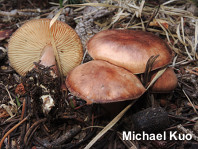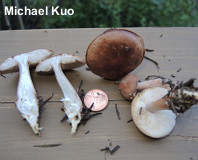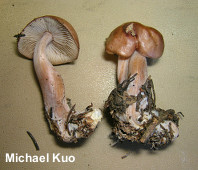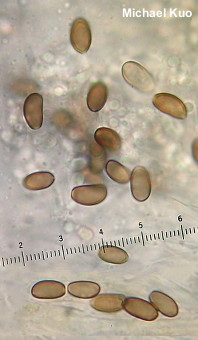| Major Groups > Gilled Mushrooms > Pale-Spored > Collybioid > Rhodocollybia butyracea |
| Major Groups > Gilled Mushrooms > Saw-Gilled Mushrooms > Rhodocollybia butyracea |

|
Rhodocollybia butyracea [ Basidiomycota > Agaricales > Omphalotaceae > Rhodocollybia . . . ] by Michael Kuo Rhodocollybia butyracea is a widespread decomposer of conifer debris, usually found under pines (species of Pinus, with bundled needles). It is very similar to Gymnopus dryophilus, but it tends to have a reddish brown, rather than yellow-brown, cap. Additionally, its stem is frequently somewhat club-shaped and its gills are often finely jagged--features not usually found in the straight-stemmed, even-gilled Gymnopus dryophilus. Some sources emphasize a difference in spore print color (pinkish for Rhodocollybia butyracea; white for Gymnopus dryophilus), but the difference, which is minimal at best, requires a very thick spore print, natural lighting, and good eyes. The best means of separating the two species is microscopic; Rhodocollybia butyracea features dextrinoid, rather than inamyloid, spores. DNA analysis by Mata and collaborators (2004) revealed at least two genetically distinct populations within "Rhodocollybia butyracea"; further research may determine that there is more than one species involved. In 2004, Mleczko identified Rhodocollybia butyracea mycelium on rootlets of Scots pine in Poland, using RFLP analysis (an early DNA-reading method, since replaced by sequencing). Mleczko described what he assumed were the ectomycorrhizae of the fungus and presented the idea that Rhodocollybia butyracea is mycorrhizal. However, later researchers (Tedersoo et al., 2010) suggest that Mleczko's methods may have led to an inaccurate conclusion, and argue that the fungus is a saprobe. Collybia butyracea is a former name. Description: Ecology: Saprobic (see discussion above); decomposing the litter of conifers—especially pines; late summer and fall (also winter and spring in warmer climates); fairly widely distributed in North America. The illustrated and described collections are from Colorado and Illinois. Cap: 2–6 cm across; convex, becoming broadly convex or nearly flat; moist, with a greasy feel, when fresh; bald; reddish brown to brown, fading to cinnamon. Gills: Narrowly attached to the stem or nearly free from it; close; short-gills frequent; whitish; often developing finely jagged edges. Stem: 3–8 cm long; and 1–2 cm thick; usually slightly to moderately club-shaped; moist or dry; bald; whitish to buff above; colored like the cap below; often with a whitish dusting when fresh; becoming hollow; basal mycelium white. Flesh: Whitish; unchanging when sliced. Odor and Taste: Not distinctive. Chemical Reactions: KOH gray on cap surface. Spore Print: Whitish or, with a thick print, faintly pinkish. Microscopic Features: Spores smooth; 8–10 x 4.5–6 µm; ellipsoid; smooth; hyaline in KOH; at least a few (often many) dextrinoid. Basidia 4-spored. Pleurocystidia not found. Cheilocystidia inconspicuous; subclavate to subcylindric; often lobed or with projections; up to 40 µm long. Pileipellis a cutis; elements 2.5–7.5 µm wide, smooth or brownish-encrusted, clamped at septa. REFERENCES: (Bulliard, 1792) Lennox, 1979. (Fries, 1821; Saccardo, 1887; Kauffman, 1918; Coker & Beardslee, 1921; Smith, Smith & Weber, 1979; Vilgalys & Miller, 1982; Halling, 1983; Arora, 1986; Phillips, 1991/2005; Barron, 1999; Mata et al., 2004; Mleczko, 2004; McNeil, 2006; Miller & Miller, 2006; Trudell & Ammirati, 2009; Antonín & Noordeloos, 2010; Tedersoo et al., 2010; Kuo & Methven, 2014; Desjardin, Wood & Stevens, 2016; Evenson, 2016; Siegel & Schwarz, 2017.) Herb. Kuo 08120701, 08021705, 11041705. Herb. DBG RMNP 2009-025, RMNP 2012 5023-04. This site contains no information about the edibility or toxicity of mushrooms. |
© MushroomExpert.Com |
|
Cite this page as: Kuo, M. (2017, November). Rhodocollybia butyracea. Retrieved from the MushroomExpert.Com Web site: http://www.mushroomexpert.com/rhodocollybia_butyracea.html |



